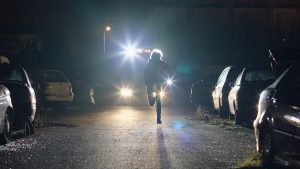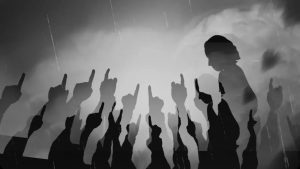The 2024 edition of the International Film Festival Rotterdam was overshadowed by the conflicts currently taking place around the world. During the opening night, IFFR director Vanja Kaludjercic spoke of the devastating events currently unfolding in Ukraine and Palestine, as well as the upcoming elections in countries such as Russia and the United States, which could play an important role in future world politics. However, within the framework of the festival, these events were seen primarily from the perspective of European audiences. As viewers, the residents of Europe have been confronted in recent years with the images and stories of extreme violence taking place around them, from the ongoing wars to the deaths of migrants and refugees along Europe’s many borders. This constant influx of information and images, whether in the news or on social media, often has a paralyzing effect, which contributes to an already widespread sense of hopelessness. The festival director notes, however, that “cinema plays a crucial role amid all this chaos.” Indeed, whether it’s experimental video essays or mainstream social and historical dramas, films can have a strong political angle. Throughout its existence, cinema has become a means of disseminating alternative discourses, informing and raising awareness, and promoting militant, dissident and radical narratives. While the IFFR’s appeal to the political potential of cinema is today as relevant as ever, one might ask how in what ways the films featured in the Tiger competition contribute to this crucial yet daunting mission.
At first glance, it may appear difficult to identify the unifying elements of the selected films. The premise of the Tiger competition is to present boundary-pushing films with strong experimental angles. However, the fourteen films in the competition varied considerably in their cinematic form, ranging from conventional fiction and creative documentaries to film essays and animation. Their content and themes were also diverse. Beyond the expected references to Ukraine and Palestine, postcolonial narratives were followed by stories of loneliness and social isolation, and superheroes appeared in more than one occasion. As a result, different perspectives can be employed to discuss the underlining logic of the specific selection and to identify its “spirit.” For instance, many of the selected films share a somewhat subversive relationship with linear time, particularly in terms of three tropes: limbo, the fusion of past and present, and temporal distortion.
First, limbo refers to the state of being confined within a place where time appears to no longer advance. Dmytro Moiseiev’s Grey Bees, set in the region of Donbas a few days before the 2022 full-scale Russian invasion, follows the daily lives of the last residents of a now almost abandoned village located in the “gray zone” that separates the Ukrainian and pro-Russian forces. For the two elderly men, time stands still as their days feel slow and interchangeable. Marked by the heavy presence of war, they reflect on their past choices, personal morals and the impossibility of taking action, as it becomes painfully obvious that they can no longer imagine any possible future. Alberto Gracia’s La Parra, shot in coastal Spain, also depicts a place isolated from the rest of the world where times stands still. Here, however, the suspension of the expected flow of time engenders strange events and, through the eyes of the main character, fantasies and nightmares arise and blend with reality. If in Grey Bees the concept of limbo creates a slow, dense cinematic time, fertile for discussions and reflections on existence, La Parra invests in temporal ellipses and discontinuities, suggesting that when time stops flowing, the very foundations of reality falter, and any absurd event can manifest to challenge our most common beliefs.

Second, a fusion of past and present appears in The Ballad of Suzanne Césaire. Director Madeleine Hunt-Ehrlich twists linear time to shed light on the life of Suzanne Césaire, the feminist anti-colonialist writer with ties to the Surrealist movement, and the wife of poet and politician Aimé Césaire. Instead of presenting her biography, though, the film re-enacts real and hypothetical scenes, in which Suzanne converses with her husband during their stay in Martinique. This re-enactment, though, is intentionally filmed as artificial and abstract, as if taking place outside of historical time, suggesting that our understanding of the past is also the product of personal fantasy and speculation. This temporal fusion is best seen in some of the shots that show Suzanne’s words and ideas echoing around the island’s trees, as if they have now become inherent parts of the island. Similarly, the past collides with the present in Julia de Simone’s Praia Formosa, inspired in part by the letters written by people trafficked from Africa to colonial Brazil. Muanza, a Kongo woman enslaved by white colons, appears to exist simultaneously in the nineteenth century and present-day Rio de Janeiro, walking the streets of a city whose time is out of sync. The film thus alludes to the many layers of histories and traumas that shape the (postcolonial) experience of contemporary urban Brazil. Whether through re-enactment or time travel, both films suggest that, rather than frozen in time, the past is subjective and in constant tension with the present.

Third, time distortion becomes central to Susie Au’s She Fell to Earth and Midhun Murali’s Kiss Wagon. The former tells the story of sentient rocks with superhuman powers that travel across the universe, while the latter delivers a three-hours animation of epic dimensions about myths, resistance against an oppressive theocratic regime, and the power of cinema to alter reality. Both films invest in a non-linear storytelling where the identity of characters changes according to repressed memories and dreams of future events come true. This distortion of time is particularly evident in Kiss Wagon, winner of the FIPRESCI award. What begins as a simple story of resistance spirals out in all possible directions as different temporalities come together. Built on a permanent tension between alternative realities, dreams and fiction, the film presents a multi-dimensional spectacle that engages the viewers’ imagination, highlighting the power of cinema to fascinate, inspire and provoke.

Playing with time has always been a fundamental part of filmmaking. Through its most fundamental tool, the editing of images, cinema has extensively explored alternative timelines and imaginary spaces. As a result, films have also been accused of manipulation, propaganda and escapism, crafting visually powerful illusions that can invade the viewers’ mind and influence their beliefs and ideology. The same tools, however, have been used in another kind of politized cinema that aims to challenge fundamental and normative conceptions and remind audiences that there are different ways of looking at reality. This is, of course, a difficult aspiration. Rather than well-hidden in a fascinating cinematic journey that appeals to the viewers’ senses and their intellect, the “message” of the films discussed here can at times seem too obvious or straightforward. They all, however, draw the viewers’ attention to their defiance of linear time in an attempt to remind us that the past and present are not set in stone, and that what we see as an inevitable future can change, as long as strong visions and political actions are still willing to playfully and poetically engage with reality. How effective a role cinema can play in the midst of all this chaos remains of course open to further discussion. However, the “spirit” behind the selection of this year’s Tiger competition can be found in a desire to remind us that images can shock but also challenge our fundamental conceptions, and open up our imagination to new (temporal) possibilities.
Antonis Lagarias
Edited by Ela Bittencourt
© FIPRESCI 2024
